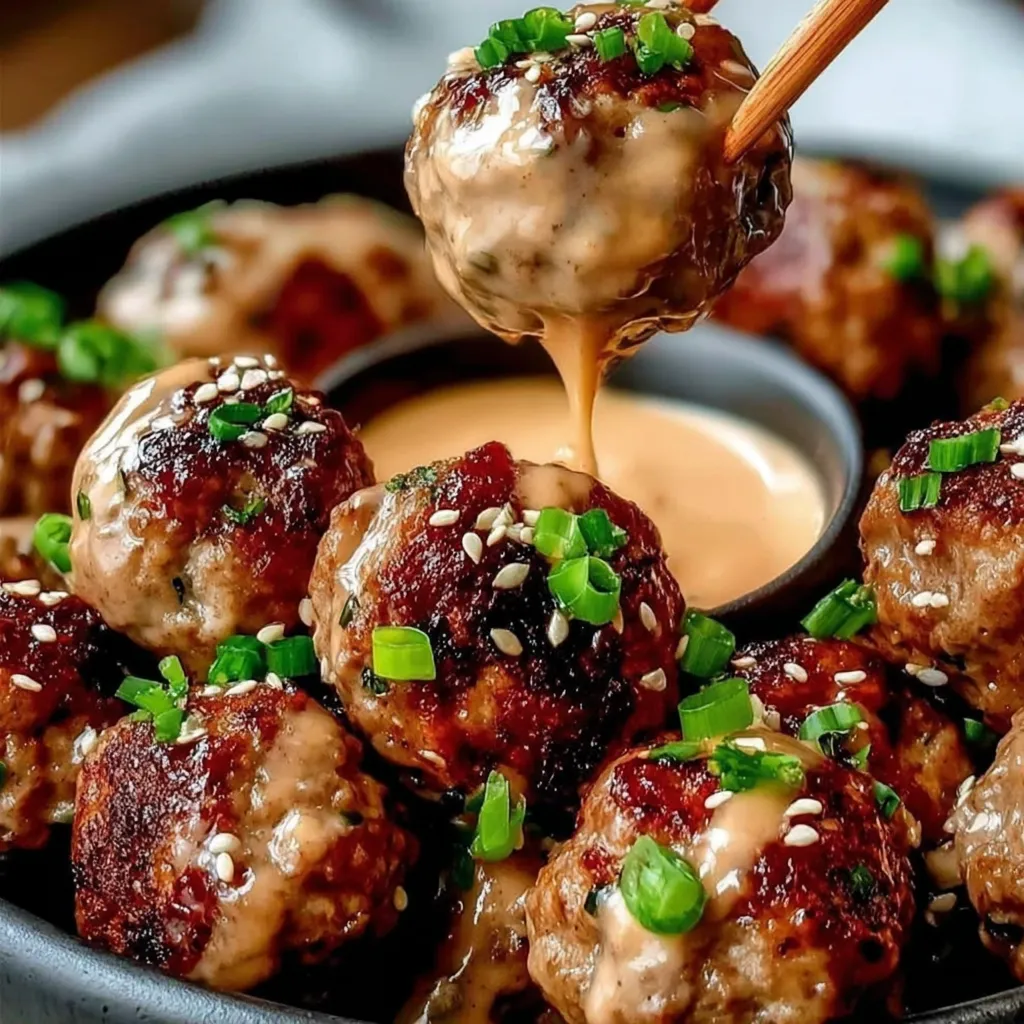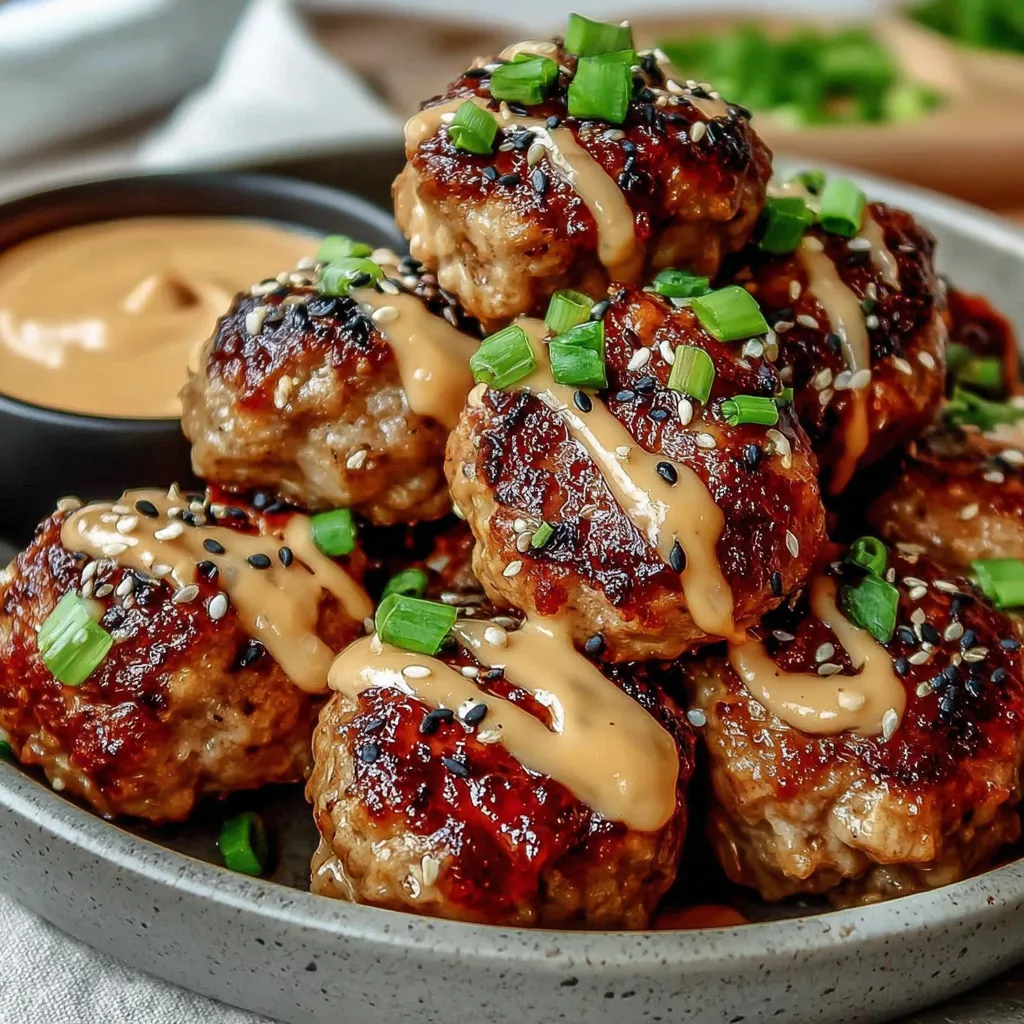 Save
Save
These Korean BBQ meatballs combine the rich, savory flavors of traditional Korean barbecue with the convenience of bite-sized portions. The spicy mayo dip adds a creamy, tangy element that perfectly complements the sweet and spicy glazed meatballs.
I first made these meatballs for a game day gathering with friends, and they disappeared faster than any other dish on the table. Since then, they've become my go-to recipe whenever I need something that's both impressive and easy to prepare.
Ingredients
- Ground beef or chicken: Provides the perfect base, with beef offering richer flavor while chicken creates a lighter version
- Panko breadcrumbs: Create a lighter texture than regular breadcrumbs, keeping the meatballs tender
- Gochujang: Brings authentic Korean flavor with its perfect balance of sweet, savory and spicy notes
- Sesame oil: Adds a distinctive nutty aroma that defines Korean cuisine
- Green onions: Provide freshness and color to balance the rich flavors
- Honey: In the glaze creates that signature Korean BBQ caramelization when cooked
- Mayonnaise: Forms the creamy base for the dip, allowing the spicy flavors to shine without overwhelming heat
Step-by-Step Instructions
- Mix the meatball ingredients:
- Combine all meatball ingredients in a large bowl, gently incorporating everything until just mixed. Take care not to overwork the meat mixture, which can lead to tough meatballs. The goal is to distribute all ingredients evenly while keeping the texture light.
- Shape uniform meatballs:
- Form approximately 1 to 1.5-inch meatballs using either your hands or a small ice cream scoop for consistency. Rolling them between your palms creates a smooth surface that will brown beautifully. Making them uniform in size ensures they'll cook evenly.
- Cook using your preferred method:
- Whether pan-frying for a delicious crust, baking for convenience, or air-frying for less oil, ensure meatballs reach the proper internal temperature. For pan-frying, allow enough space between meatballs to prevent steaming. When baking, arrange them with small gaps between each one for even heat circulation.
- Prepare the Korean BBQ glaze:
- Simmer all glaze ingredients in a small saucepan, stirring frequently to prevent burning. The cornstarch slurry is crucial for creating that sticky, clingy texture that coats the meatballs perfectly. Cook until the glaze coats the back of a spoon but isn't too thick to pour.
- Coat the meatballs:
- Gently toss the cooked meatballs in the warm glaze, using a folding motion to ensure each meatball gets evenly coated without breaking apart. The meatballs should glisten with sauce but not be swimming in it.
- Make the spicy mayo dip:
- Whisk all dip ingredients until completely smooth. The consistency should be thick enough to cling to the meatballs when dipped but still easily spreadable. Let it sit for 5-10 minutes before serving to allow flavors to meld.
- Garnish and serve:
- Arrange glazed meatballs on a serving platter, garnish generously with sesame seeds and green onions, and serve immediately with the spicy mayo dip alongside. The contrasting colors create a visually appealing presentation.

The gochujang is really the star ingredient here. I discovered its magic after a Korean friend brought some to a potluck, and I've been obsessed ever since. My family now keeps at least two containers in our refrigerator at all times because it adds incredible depth to any dish.
Make-Ahead Tips
These meatballs are perfect for meal prep and actually develop even better flavor overnight. You can prepare the raw meatball mixture up to 24 hours ahead and refrigerate it, covered. For longer storage, form the meatballs and freeze them uncooked on a baking sheet before transferring to freezer bags. The glaze and spicy mayo can also be made up to 3 days ahead and stored separately in airtight containers in the refrigerator.
Ingredient Substitutions
No gochujang? You can substitute with a mixture of 1 part sriracha, 1 part miso paste, and a pinch of sugar to approximate the flavor profile. For a gluten-free version, replace panko with crushed rice crackers or certified gluten-free breadcrumbs. The recipe works beautifully with ground turkey or plant-based meat alternatives if you prefer. For a dairy-free spicy mayo, look for vegan mayonnaise options at your grocery store.

Serving Suggestions
These meatballs are incredibly versatile. Serve them over steamed rice with kimchi on the side for a complete meal, or offer them as appetizers with decorative toothpicks for easy eating. They also make excellent lettuce wraps when tucked into butter lettuce leaves with some pickled vegetables and extra sauce. For a fusion twist, try them in slider buns with the spicy mayo and some quick-pickled cucumbers.
Storage Instructions
Store leftover meatballs in an airtight container in the refrigerator for up to 3 days. The glaze tends to thicken when cold, so when reheating, add a splash of water or broth to loosen it. Reheat gently in the microwave or in a covered skillet with a tablespoon of water to maintain moisture. The spicy mayo will keep for up to a week refrigerated and actually develops more flavor over time.
Recipe FAQs
- → Can I make these Korean BBQ meatballs ahead of time?
Yes! You can prepare the meatball mixture and shape them up to 24 hours in advance, storing them covered in the refrigerator. You can also fully cook the meatballs, cool them, and refrigerate for up to 3 days. Reheat in a 350°F oven for 10 minutes until warmed through, then toss with freshly made glaze.
- → What can I substitute for gochujang if I can't find it?
While gochujang has a unique flavor, you can substitute with 1 tablespoon sriracha mixed with 1/2 teaspoon miso paste and 1/2 teaspoon brown sugar. Alternatively, use 2 teaspoons tomato paste mixed with 1 teaspoon red pepper flakes and 1/2 teaspoon honey for a similar sweet-spicy profile.
- → How do I know when the meatballs are fully cooked?
The most reliable method is using an instant-read thermometer—beef meatballs should reach 160°F (71°C) and chicken meatballs should reach 165°F (74°C). If you don't have a thermometer, cut one open; beef should be no longer pink inside, and chicken should be completely white throughout.
- → What sides pair well with Korean BBQ meatballs?
These meatballs pair beautifully with steamed rice, kimchi, pickled vegetables, or a simple cucumber salad. For a complete Korean-inspired meal, serve with bibimbap components like sautéed spinach, carrots, bean sprouts, and a fried egg. They also work well alongside japchae (Korean glass noodles) or as part of a Korean BBQ spread.
- → Can I make these meatballs gluten-free?
Yes! Replace the panko breadcrumbs with gluten-free breadcrumbs or crushed rice crackers. Make sure to use gluten-free soy sauce or tamari in both the meatball mixture and glaze. Check that your gochujang is gluten-free as some brands may contain wheat-based ingredients.
- → How spicy are these meatballs?
With the amount of gochujang specified, these meatballs have a medium spice level. For a milder version, reduce the gochujang by half in both the meatballs and sauce. For extra heat, increase the gochujang or add 1/2 teaspoon of Korean red pepper flakes (gochugaru) to the mixture.
